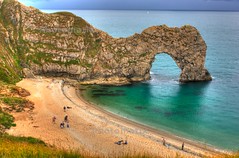
Durdle Door
Originally uploaded by Di Di's Trip pics
Rough Guides' photography is classically show-it-like-it-is-but-on-a-really-good-weather-day, yet the reality of acquiring such images within the given timescale, with the given budget AND in the UK isn't quite as luxurious as perhaps a wannabe travel photographer would hope for. Plus, not being too conversant with the region and not having the time to research every little detail, I often turn up at places and don't known what to expect. There are some measures I take which help; for example, I always carry a compass so I can work out where the sun will be at other times of the day or how the subject will be illuminated at sunrise or sunset. But what to do if to get to that shot it took a long drive followed by an uphill walk and five pounds in parking fees only to discover it's about to piss down with rain any moment and I most certainly won't want to return and reshoot it any time soon?
As with any landscape shot, it's incredibly difficult to render all the different elements in one shot by metering on just one part of it. Meter on the sky and you underexpose the rocks, meter on the sea and blow out the sky. Unless you're there amidst the most incredible sunset or sunrise, it's highly unlikely that you can do anything to alter the light in the shot (you'd need god-like powers, I'd imagine and failing that, perhaps steal a few floodlights from a nearby football pitch). It actually wasn't all that tricky to get to Durdle Door but, in case I run out of time later on and don't manage to return, I knew I had to take the shots seeing as I'd made every effort to get there.
The sky was stormy yet there was interesting diffuse light illuminating the sea and the rocks. There were no huge areas of dark shadows like there would be if there had been no cloud cover but, equally, there was still a discrepancy between the light levels on the different parts of my composition. A few test shots revealed a fairly dull and lifeless Durdle Door. It's such an iconic Dorset image that I could hardly return to Sarah with these grey-day shots.
I'd heard and read a bit about HDR (High Dynamic Range imaging; http://en.wikipedia.org/wiki/High_dynamic_range_imaging) processing in the last year or so and, despite being thoroughly impressed with the fairground-bright colours achievable using the process, I wasn't sure such vivid brilliance would be appropriate for a Rough Guide shot. BUT, what if I could use the process to create an image that might not be an exact rendering of what I saw but yet something that makes the scene more desirable than a wet June weekend would otherwise be?
It's really easy to take the bracketed exposures on the D2Xs; just whang the camera into constant shooting mode and then choose how many bracketed exposures to take. In this case I went for 5 exposures; one on the nose, two under and two over. They looked pretty odd when flicking through the memory card and I left Durdle Door feeling pretty disillusioned and knew I'd probably need to return on a sunnier day.
This image here is my first experiment with Photomatix the HDR rendering program. I've only got the trial version (hence the watermarks) but I think I'm sold on it already so might fork out for the full version. I feel I ought to upload the dreary, one-shot Durdles so you can see quite how much illumination and colour the process has brought to the composition.
BUT, does it look real? Or does it look hypereal? Should I continue using this process for the dreary days or should I camp out and wait for the perfect sunrise? Well, sunset; I'm certainly no early riser and, according to my compass readings, I reckon Durdle Door will look better in the evening light than in the morning.

No comments:
Post a Comment